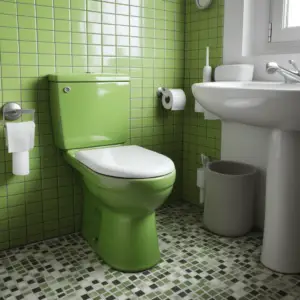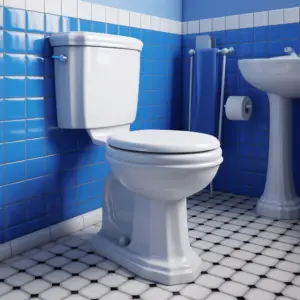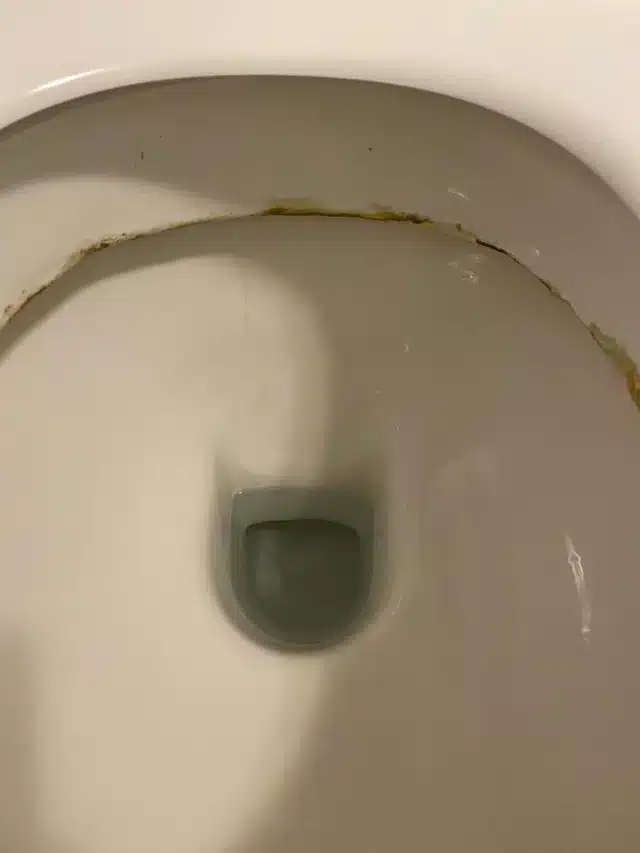Out of nowhere, it seems, your toilet gets a layer of ugly limescale. It forms onto the toilet bowl, encased in off-white and horrible. You want to scrub and scrub, but it’s not coming off as it once did. It’s as if the toilet is permanently stained with a hideous mold.
A lot of bathrooms suffer from this problem, and it is really something that makes a big difference to the look of your bathroom as well as to the smooth running of the fixtures.
In this post, we’re going to show you how to remove limescale from the toilet waterline, as well as give you some tips on how to prevent any scale buildup in the future.
Table of Contents
What is Limescale and What Causes It?

Limescale is a mineral deposit that forms on the inside of your water tank, pipes, and fittings. It’s made up of calcium, magnesium, and carbonates and can be yellow, greyish, or white.
Limescale forms when hard water evaporates from your toilet bowl, leaving behind minerals in the tank. Over time these minerals form into limescale crystals that stick to your toilet bowl and leave stains.
Limescale can also form on other parts of your plumbing system, such as taps or shower heads, but it’s most common in toilets because they’re used every day and have less contact with air than other fixtures in your home.
It’s also more noticeable because you see it when you look down into the bowl – unlike other places which are hidden away from sight under sinks or bathtubs.
If you have a toilet with an enamel finish, avoid using abrasive cleaners. These can damage the surface of your toilet and cause stains.
How to Remove Limescale From Toilet Below Waterline
To remove limescale from your toilet below the waterline, you first need to remove all of the water from it. This will allow you to clean the area more thoroughly and reduce the risk of diluting any cleaning materials you use, which would make them less effective.
Follow These Steps To Drain Your Toilet Bowl
Step 1: Turn off your toilet’s water supply to prevent the bowl from filling up again. If you don’t have a shutoff valve in your toilet, turn off the main water supply to your house.
Step 2: Flush the toilet and allow it to drain completely. This will remove any standing water in the bowl and allow you to clean more effectively.
Step 3: After draining out all the water from the tank, use a small container or cup to scoop up the remaining water.
Use a sponge or cloth to wipe out any remaining residue from inside the bowl.
Make sure that no water remains in the toilet bowl before proceeding with the next step.
Here are several ways to get rid of limescale on the toilet below the waterline:
(Don’t forget to wear gloves when using these products as they may irritate your skin if left on too long!)
Use a Descaling Liquid
If you have a lot of buildup, then you may need to remove it by hand. This can be very time-consuming and messy. You can use descaling liquids to help loosen the limescale before scrubbing it off with a brush.
Descaling liquids contain acids that react with water to form an alkali that dissolves lime deposits. However, these liquids are not advised for use on chrome or enamel surfaces because they can damage them.
There is also a special kind of toilet brush that is designed for removing limescale from below the waterline. It has a long handle so it can reach into deep areas, and it has a shaped head that allows water to wash away loosened deposits as you scrub them away.
Use Baking Soda & Vinegar
You can also use baking soda and vinegar to remove limescale from your toilet. Mix equal quantities of both these ingredients, add some water, and apply to your toilet bowl with a sponge or cloth for about 30 minutes. After 30 minutes, wash off all traces of this mixture with warm water and then dry your toilet well before using it again.
Viakal and Lots of Scrubbing
Limescale can be removed by using a substance called ‘Viakal’ (a limescale remover).
This is a powerful chemical that comes with a strong smell, but it does wonders when it comes to removing stains and limescale from your home.
The best part about this ingredient is that it doesn’t damage the surface of your toilet bowl while at the same time getting rid of all stains and limescale!
Toilet Bowl Cleaner Tabs

You can use these tablets to clean your toilet bowl and take care of limescale. These are non-toxic and eco-friendly too.
The best part is that you do not need any special equipment or skills to use these tablets as they come in the form of tablets, which you just have to drop into your toilet bowl and let them work their magic by dissolving the limescale deposits present on the walls of your toilet bowl.
Try Using Coke
The acid in coke is strong enough to dissolve limescale, so pour some into the toilet bowl and leave it overnight.
The next morning the limescale should have dissolved. If not, repeat until all traces are gone, or try some of the other suggestions in this post.
Try WD40
A squirt of WD40 (or similar penetrating oil) is said to do wonders for removing hard-water deposits from toilets, sinks, and bathtubs, so give it a try if all else fails!
Conclusion
I’m sure you’ve seen it in your bathroom at some point: disgusting limescale buildup inside your toilet bowl usually found just above the water line.
It grows in the most common place you would expect: the area with the most moisture.
But cleaning the toilet bowl below the waterline can be a little tricky. You need to use some ingredients that are good for removing limescale from toilet bowls below the waterline without damaging them or making them look worse than before you started cleaning.


